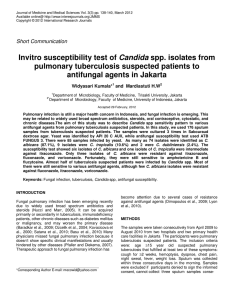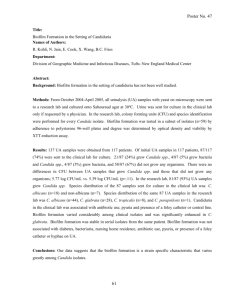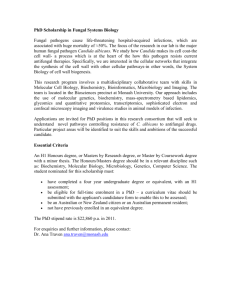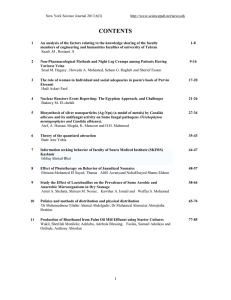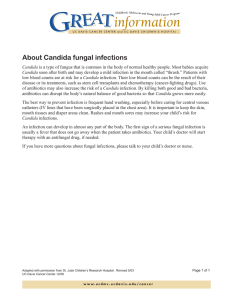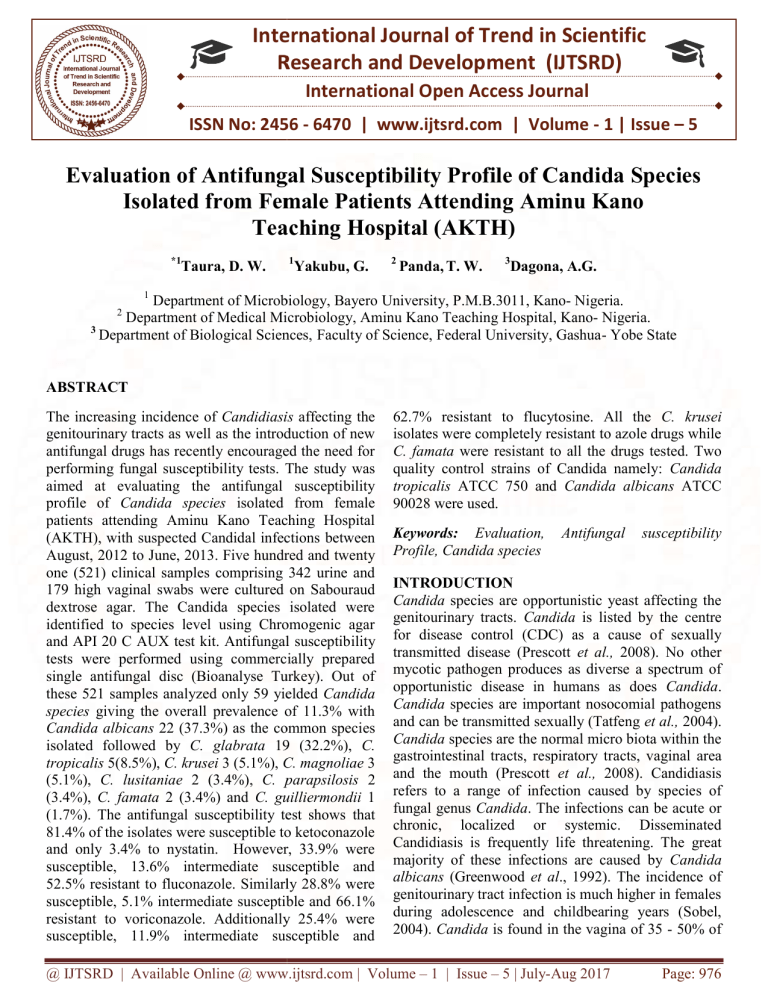
International Journal of Trend in Scientific
Research and Development (IJTSRD)
International Open Access Journal
ISSN No: 2456 - 6470 | www.ijtsrd.com | Volume - 1 | Issue – 5
Evaluation of Antifungal Susceptibility Profile of Candida Species
Isolated from Female Patients Attending Aminu Kano
Teaching Hospital (AKTH)
*1
Taura, D. W.
1
Yakubu, G.
2
Panda, T. W.
3
Dagona,
agona, A.G.
A.G
1
Department of Microbiology, Bayero University, P.M.B.3011, Kano- Nigeria.
Department of Medical Microbiology, Aminu Kano Teaching Hospital, KanoKano Nigeria.
3
Department of Biological Sciences, Faculty of Science, Federal University, GashuaGashua Yobe State
2
ABSTRACT
The increasing incidence of Candidiasis affecting the
genitourinary tracts as well as the introduction of new
antifungal drugs has recently encouraged the need for
performing fungal susceptibility tests. The study was
aimed at evaluating the antifungal susceptibility
profile of Candida species isolated from female
patients attending Aminu Kano Teaching Hospital
(AKTH), with suspected Candidal infections between
August, 2012 to June, 2013.. Five hundred and twenty
one (521) clinical samples comprising 342 urine and
179 high vaginal swabs were cultured on Sabouraud
dextrose agar. The Candida species isolated were
identified to species level using Chromogenic agar
and API 20 C AUX test kit. Antifungal susceptib
susceptibility
tests were performed using commercially prepared
single antifungal disc (Bioanalyse Turkey). Out of
these 521 samples analyzed only 59 yielded Candida
species giving the overall prevalence of 11.3% with
Candida albicans 22 (37.3%) as the common speci
species
isolated followed by C. glabrata 19 (32.2%), C.
tropicalis 5(8.5%), C. krusei 3 (5.1%), C. magnoliae 3
(5.1%), C. lusitaniae 2 (3.4%), C. parapsilosis 2
(3.4%), C. famata 2 (3.4%) and C. guilliermondii 1
(1.7%). The antifungal susceptibility test shows that
81.4% of the isolates were susceptible to ketoconazole
and only 3.4% to nystatin. However, 33.9% were
susceptible, 13.6% intermediate susceptible and
52.5% resistant to fluconazole. Similarly 28.8% were
susceptible, 5.1% intermediate susceptible and 66.1%
resistant to voriconazole. Additionally 25.4% were
susceptible, 11.9% intermediate susceptible and
62.7% resistant to flucytosine. All the C. krusei
isolates were completely resistant to azole drugs while
C. famata were resistant to all the drugs tested.
tes
Two
quality control strains of Candida namely: Candida
tropicalis ATCC 750 and Candida albicans ATCC
90028 were used.
Keywords: Evaluation,
Profile, Candida species
Antifungal
susceptibility
INTRODUCTION
Candida species are opportunistic yeast affecting the
genitourinary tracts. Candida is listed by the centre
for disease control (CDC) as a cause of sexually
transmitted disease (Prescott et al., 2008). No other
mycotic pathogen produces as diverse a spectrum of
opportunistic
portunistic disease in humans as does Candida.
Candida species are important nosocomial pathogens
and can be transmitted sexually (Tatfeng et al., 2004).
Candida species are the normal micro biota within the
gastrointestinal tracts, respiratory tracts, vaginal
vag
area
and the mouth (Prescott et al., 2008). Candidiasis
refers to a range of infection caused by species of
fungal genus Candida.. The infections can be acute or
chronic, localized or systemic. Disseminated
Candidiasis is frequently life threatening. The
T great
majority of these infections are caused by Candida
albicans (Greenwood et al.,
., 1992). The incidence of
genitourinary tract infection is much higher in females
during adolescence and childbearing years (Sobel,
2004). Candida is found in the vagina of 35 - 50% of
@ IJTSRD | Available Online @ www.ijtsrd.com | Volume – 1 | Issue – 5 | July-Aug
Aug 2017
Page: 976
International Journal of Trend in Scientific Research and Development (IJTSRD) ISSN: 2456-6470
healthy women. Under some conditions, such as Candida were in the Intensive care unit (ICU) where
reduced immunity, prolonged antibiotics therapy, use bladder catheter use was high (Shay and Miller,
of contraceptives, malnutrition, pregnancy, diabetes, 2004). The aim of the present research was to carry
obesity, tissue transplant, use of immunosuppression out antifungal potency evaluation test against Candida
drugs (Corticosteroids), neutropenia, Candida may species isolated from female patients attending Aminu
become
pathogenic
and
cause
Candidiasis Kano Teaching Hospital. These antifungal agents
(Okungbowa et al., 2003). Candida species are the inhibit macromolecule synthesis (Flucytosine), impair
second most frequent isolates from blood cultures in membrane barrier function (polyenes), inhibit
hospitals
with
large
populations
of ergosterol synthesis (allylamines, thiocarbamates,
immunocompromised patients (Beck Sague et al., azole derivatives, and morpholines) or interact with
1993 Tatfeng et al., 2004). In broader sense fungal microtubules (Vanden et al., 1997).. Emergence of
diseases became recognized as being of clinical drug resistance among yeast isolates and consequent
importance in the second half of the last century. This increase in serious fungal infections have been
is mainly due to advancement in medical technologies reported (DeMuri et al., 1995). The mechanism of
(Rizvi et al., 2011). With the remarkable modern resistance to these antifungal agents by yeast isolates
advances in medicine, there has been an increase in are purely chromosomal as Candida species lack
the number of immuno compromised individuals who plasmid or other natural mechanism capable of
need extensive care in the hospitals (Rizvi et al., transferring genetic materials between strains (Odds et
2011). This has resulted in a rise in the incidence of al., 2003). Knowledge of mechanisms of antifungal
fungal infections, especially those due to Candida resistance has been valuable in identifying resistant
species (Rizvi et al., 2011). Among the species only isolates and using them to validate in vitro
nine are frequent pathogens for human (Andy et al., measurement systems (Ghannoum, et al, 1999,
2004). Candida albicans is the most common fungal Moore et al, 2000, Vanden Bossche, et al 1998 and
causative agent in superficial and deep seated White et al, 1998).
Candidiasis. However, non- albicans are also being
implicated in recent years (Gullo, 2009). However, Study Area
infection of the vulva and vagina with Candida The study was conducted in the microbiology
albicans is termed vulvovaginal Candidiasis. This is laboratory of Aminu Kano Teaching Hospital
characterized by intense vulval and vaginal irritation (AKTH) Kano. The hospital is located in the
(itching) which often gives rise to inflammation, metropolitan city of Kano in Tarauni LGA. It serves
soreness, redness and white spots in and around the as a referral centre for diseases that could not be
genital tract. Also, painful urination and intercourse manage by other hospitals within the Kano environs
are associated with the infection. In about 5% cases of and some neighbouring states.
Candidal vulvovaginitis, the disease has a chronic
course showing frequent and refractory episodes Study Population
(Ferrer, 2000). Additionally, various studies have The study targeted only female patients that were sent
shown that nearly 75% of all women will experience to microbiology laboratory by clinicians with a
at least one attack of Candidal vulvovaginitis during request form and are suspected having Candidiasis.
their life time and suffer multiple episodes (Ferrer, Those that did not meet the above criteria were not
2000; Saporiti et al., 2001).The presence of Candida included in this study.
in urine is called candiduria. This is rarely
encountered in otherwise healthy people with Sample Size
structurally normal urinary tract (Schonebeck and A total of 521 clinical samples including 342 urine
Ansehn, 1972; Kauffman, 2005 and Bukhary, 2008). and 179 high vaginal swabs were collected and
It is however of common occurrence in hospitalized analyzed from female patients attending Aminu Kano
patients. Candida species account for almost 10-15% Teaching Hospital with suspected cases of
of nosocomial urinary tract infections (UTIs) Candidiasis between august, 2013 to June, 2014.
(Kauffman et al., 2000; Lundstrom and Sobel, 2001
and Kauffman, 2005).In the United States it is Ethical Clearance
estimated that the incidence of candiduria was 25,000 This was obtained from the hospital ethical committee
cases per year. And approximately one third of prior to the commencement of the study. In addition,
hospitalized patients with urine cultures yielding an informed consent was sought from patients before
@ IJTSRD | Available Online @ www.ijtsrd.com | Volume – 1 | Issue – 5 | July-Aug 2017
Page: 977
International Journal of Trend in Scientific Research and Development (IJTSRD) ISSN: 2456-6470
their enrolment. Those that refused to be recruited isolates were first sub culture on SDA in order to
after much explanation were not considered in the obtain fresh colonies of the organism. Colonies were
research.
picked by successive touches and introduced in to a
sterile test tube containing 2ml (0.85%) normal saline.
The turbidity was measured visually to match with 2
SAMPLE COLLECTION
Urine Collection and Processing Fresh morning mid- Mc Farland standard as directed by the manufacturer.
stream urine samples were aseptically collected in And then 100 µl of the suspension was pipetted with
clean, dry culture bottles. Patients have been told to micro titre pipette and dispensed into API media.
first allow urine to flow out and collect the mid- Further transfer of suspension was done from API
stream in a sterile screw cap container and then media to API strip that is made up of 20 cupules. The
replace the lid firmly and bring the samples to the cupules were filled with the API media already
microbiology laboratory.
For each specimen containing the test organism and then incubated at
collected, Age, Sex, Laboratory number, and Name of 290C for 48 – 72 hrs as directed by the manufacturer.
patients were clearly labelled. At laboratory, the urine The cupules are already pre-coated with sugars except
was first transferred into a sterile test tube and the first cupule that serve as control. After incubation,
centrifuged at 3000 rpm for 5 minutes. After growth in each cupule was compared with the control.
centrifugation, the supernatant was decanted and the A cupule that is more turbid than the control was
sediment was streaked on to SDA (Himedia) with the recorded in the result sheet as positive. On the result
aid of a standard wire loop calibrated to hold (0.01) sheet the tests are separated into seven groups with
ml urine. Specimens were incubated at 370C for 24- 48 each group bearing three digits numbers of 1, 2 and 4.
hrs. Wet film was then prepared and the remaining Therefore, by adding the numbers corresponding to
portion of the sediment was placed on a dried grease positive reactions within each, a 7 digits number is
free slide and stained using Gram`s method. obtained which constitute the numerical profile. The
Microscopy was followed to observe the presence of final identification was done by checking the seven
yeast cells. High Vaginal Swab Collection and digits number in the API booklet, where yeast species
Processing .High vaginal swab samples were are provided with codes that correspond to Excellent,
collected aseptically in sterile cotton tipped swab stick Very Good, Good and Acceptable Identifications.
by a trained female nurse officer. The specimens Antifungal Susceptibility Test Disk diffusion method
were properly labelled and then transported to the using commercially prepared antifungal single disk
laboratory for analysis. Upon receipt at the laboratory (Bioanalyse) Turkey was employed as recommended
samples were inoculated on SDA (Himedia) directly by (National committee for clinical laboratory
using the cotton tipped swab stick and then spread by standards (NCCLS-M44A, 2004).
streaking with standard sterile wire loop. Specimens
were incubated at 37OC for 24 - 48 hrs. The swab was Procedure: Fresh culture of each isolate of not more
then replaced back to its container and 2-3 drops of than 18- 24 hrs old as recommended by the company
normal saline were added. This was shaken were suspended in a sterile test tube containing 5ml
vigorously and dispensed in to a sterile test tube. The (0.85%) normal saline. The turbidity was measured
specimen was centrifuged at 3000 rpm for 5 minutes, visually to match with 0.5 Mc Farland standard.
supernatant was decanted and a wet film prepared to Sterile cotton tipped swab stick was then dipped into
observe the presence of yeast cells. Part of the the suspension containing the organism to be tested.
sediment was used for Gram staining. The stained The cotton tipped swab stick was then raised above
slides were examined under microscope for budding the suspension and pressed along the inner wall of the
yeast cells. Identification and Characterization Yeast test tube to remove excess moisture. This was
isolates were identified to specie level using inoculated on dried plate of Muller Hinton agar
Chromogenic Agar and API 20C Aux kit Biomeriuxµ supplemented with 2% Glucose and 0.5g Methylene
company of France. Inoculation on Chromogenic Blue by swabbing at 600 in three dimensions for
Agar Yeast isolates were first sub cultured on SDA uniformity as recommended by (National committee
(Himedia) to obtained pure/ fresh colonies of the on clinical laboratory standards M44A, 2004). The
organism to be tested. Chromogenic agar was then glucose supports the growth of Candida species while
prepared according to manufacturer guidelines. The Methylene Blue enhanced zone and edge clarity.
yeast isolates were sub culture on to the media and Sterile single discs were aseptically placed on each
incubated for 24 - 48 hrs. API 20 AUX C Kit, Yeast inoculated plate with the aid of sterile forcep and
@ IJTSRD | Available Online @ www.ijtsrd.com | Volume – 1 | Issue – 5 | July-Aug 2017
Page: 978
International Journal of Trend in Scientific Research and Development (IJTSRD) ISSN: 2456-6470
incubated at 37OC for 18 - 48 hrs. The zone of the isolates were susceptible to Ketoconazole. While
inhibition produced by each antifungal disc was 62.5% of the isolates were susceptible to Fluconazole,
measured with a calibrated ruler, and then interpreted only 50% were susceptible to Voriconazole and
based on the interpretive break points recommended Flucytosine respectively. Interestingly, C. famata was
by ((CLSI, M44, 2004) M44, 2004). In this case only resistant to all the agents and in addition none of the
fluconazole and voriconazole interpretive break points isolates was susceptible to Nystatin. Similarly C.
were provided. However, the response to other tropicalis
was only susceptible to ketoconazole
antifungal agents for which no interpretive break while C. albicans was susceptible to all the agents
points provided by CLSI, these were interpreted except Nystatin (Table 3).However, high vaginal
according to the manufacturer’s instructions (Table swab (HVS) isolates shows a different susceptibility
1). Also, two quality control strains of Candida pattern on comparison with urine counterpart in which
namely: C. albicans ATCC 90028 and Candida 82.4% of the isolates were susceptible to
tropicalis ATCC 750 were used.
Ketoconazole and were 29.4% susceptible, 13.73%
intermediate susceptible and 56.9% resistant to
fluconazole. Similarly 25.5% of the isolates were
RESULTS
In this research a total of 521 samples including 342 susceptible to Voriconazole, 5.9% intermediate and
and 179 Urine and High vaginal swabs respectively 68.63% resistant. Highest resistance was observed in
were processed and analyzed, out of which only 59 nystatin (96.1%).
In addition, C. famata and C.
(11.3%) were Candida species (Table 1). However, guilliermondii were resistant to all the agents except
the prevalence of Candida species in urine was 8 that C. famata was susceptible to only Ketoconazole.
(2.3%). The species isolated were C. albicans of Table 5 presents the overall susceptibility profile of
about 3 (37.5%), C. glabrata, C. tropicalis, C. famata, the isolates. The result demonstrated that 81.4% were
C. parapsilosis, and C. magnoliae each with 1(12.5%) susceptible to Ketoconazole. However, 33.9% were
respectively. Higher prevalence of 51(28.5%) was susceptible to Fluconazole, 13.6% intermediate and
recorded in high vaginal swab samples which includes 52.5% resistance. Similarly, Flucytosine 25.4% were
C. albicans 19 (37.3%) followed by C. glabrata susceptible, 11.9% intermediate and 62.7% resistance.
18(35.3%), C. tropicalis 4(7.8%), C. krusei 3(5.9%), Surprisingly, 96.6% of the isolates were completely
C. magnoliae and C. lusitaniae 2(3.9%) each, C. resistant to nystatin. While only C. albicans and C.
parapsilosis, C. famata, and C. guilliermondii glabrata were susceptible to Nystatin, C.
1(1.96%) respectively. The predominant specie guilliermondii C. krusei were completely resistant to
isolated in both the clinical samples was C. albicans all the agents except that C. krusei was intermediate
(Table 2). With the respect to antifungal susceptibility susceptible to flucytosine.
profile of urine isolates, the result shows that 75% of
Table1. Prevalence of Candida species in the clinical samples
Samples
Number
processed
Number positive
Prevalence (%)
Urine
342
8
2.3
High vaginal swab 179
51
28.5
Total
59
11.3
521
@ IJTSRD | Available Online @ www.ijtsrd.com | Volume – 1 | Issue – 5 | July-Aug 2017
Page: 979
International Journal of Trend in Scientific Research and Development (IJTSRD) ISSN: 2456-6470
Table2. Prevalence and distributions of Candida species in the clinical samples
S/n
1
2
3
4
5
6
7
8
9
Isolates
C. albicans
C. glabrata
C. tropicalis
C. krusei
C. magnolia
C. lusitaniae
C. parapsilosis
C. famata
C. guilliermondii
Total
High vaginal swab
19(37.30)
18(35.30)
4(7.80)
3(5.90)
2(3.90)
2(3.90)
1(1.96)
1(1.96)
1(1.96)
51
Urine
3(37.5)
1(12.5)
1(12.5)
0(0)
1(12.5)
0(0)
1(12.5)
1(12.5)
0(0)
8
Total
22(37.3)
19(32.2)
5(8.5)
3(5.1)
3(5.1)
2(3.4)
2(3.4)
2(3.4)
1(1.7)
59(100)
Key = Values in parentheses are percentage, S/n serial number
Table3. Antifungal susceptibility profile of urine Candida isolates
S/n
ISOLATES
N
1
C. albicans
3
2
C. glabrata
1
FLU
VOR
NYS
S I R
S I
R
2
0 1
2
0
1
1
0
0
0
0
0
0
1
0
0
1
S
5FC
KTC
I
R
S
I
R
S
I
R
0
-
3
2
0
1
2
-
1
1
0
-
1
1
0
1
1
-
0
0
1
0
-
1
0
0
1
1
-
0
1
0
0
0
-
1
0
0
1
1
-
0
0
0
0
1
0
-
1
0
0
1
0
-
1
0
1 0
0
0
-
1
1
0
0
1
-
0
0
3
C. tropicalis
1
4
C. parapsilosis
1
1
0
5
C. famata
1
1
6
C. magnolia
1
0
Total
Percentage %
8
5 0 3
4 0 4
0
8
4
0
4
6
2
62.5
0
50 0 50 0
- 100
50
0
75 - 25
37.5
50
Keys = N, number, Flu, fluconazole, Vor, voriconazole, Nys, nystatin, 5fc, flucytosine and KTC,
ketoconazole, S sensitive, I intermediate sensitive, R resistant, S/n serial number
@ IJTSRD | Available Online @ www.ijtsrd.com | Volume – 1 | Issue – 5 | July-Aug 2017
Page: 980
International Journal of Trend in Scientific Research and Development (IJTSRD) ISSN: 2456-6470
Table 4: Antifungal susceptibility profile of high vaginal swab Candida isolates
S/n ISOLATES
1
2
3
4
5
6
7
8
9
C. albicans
C. glabrata
C. tropicalis
C. krusei
C. magnolia
C. lusitaniae
C. parapsilosis
C. famata
C. guilliermondii
Total
Percentage%
N FLU
S
I R
19 5 1 13
18 8 4
6
4 1
0 3
3 0
0 3
2 0
1
1
2 0
1
1
1 1
0
0
1 0
0
1
1 0
0
1
51 15 7 29
29.4 13.3 56.9
VOR
S
I
R
5 0
14
5
3 10
1 0
3
0 0
3
1 0
1
0
0
2
1
0
0
0
0
1
0 0
1
13
3 35
25.5 5.9 68.63
NYS
S
I
R
1 18
1 17
0
4
0
3
0
2
0 2
0
1
0
1
0
1
2 - 49
3.9 - 96.1
5FC
S
I R
1
0 18
9
5
4
0
1
3
0
1
2
0
0
2
0 0
2
0
0
1
0
0
1
0 0
1
10 7
34
19.61 13.73 66.7
KTC
S
I
R
16
- 3
17
1
4
0
0
3
2
0
1
1
1
- 0
1
- 0
0
- 1
42
9
82.4 - 17.6
Keys = N, number, Flu, fluconazole, Vor, voriconazole, Nys, nystatin, 5fc, flucytosine and KTC,
ketoconazole, S sensitive, I intermediate sensitive, R resistant, S/n serial number
Table 5: Overall susceptibility profile of the isolates
S/n ISOLATES
N FLU
S
VOR
NYS
I
R
S
I
R
S
I
5FC
R S
21
KTC
I
R
S
I
R
3
0
19
18
-
4
1
C. albicans
22 7
1
14
7
0
15
1
-
2
C. glabrata
19 9
4
6
5
3
11
1
- 18
10
5
4
18
-
1
3
C. tropicalis
5
1
0
4
1
0
4
0
-
5
0
1
4
5
-
0
4
C. krusei
3
0
0
3
0
0
3
0
-
3
0
1
2
0
-
3
5
C. magnoliae
3
1
1
1
2
0
1
0
-
3
1
0
2
3
-
0
6
C. lusitaniae
2
0
1
1
0
0
2
0
-
2
0
0
2
1
-
1
7
C. parapsilosis
2
2
0
0
2
0
0
0
-
2
0
0
2
2
-
1
8
C. famata
2
0
1
1
0
0
2
0
-
2
1
0
1
1
-
1
9
C. guilliermondii 1
0
0
1
0
0
1
0
-
1
0
0
1
0
-
1
Total
20
8
31
17
3
39
2
-
57
15
7
37
48
-
11
Percentage %
33.9 13.6 52.5 28.8 5.1 66.1 3.4 -
96.6 25.4 11.9 62.7 81.4 -
18.6
Keys = N, number, Flu, fluconazole, Vor, voriconazole, Nys, nystatin, 5fc, flucytosine and KTC,
ketoconazole, S sensitive, I intermediate sensitive, R resistant, S/n serial number
@ IJTSRD | Available Online @ www.ijtsrd.com | Volume – 1 | Issue – 5 | July-Aug 2017
Page: 981
International Journal of Trend in Scientific Research and Development (IJTSRD) ISSN: 2456-6470
C. albicans as the commonest yeast specie isolated in
their studies. On the other hand, the result of
DISCUSSIONS
antifungal susceptibility test carried out showed that
Vaginal discharge is one of most frequent resistance to nystatin was (96.1 to 100) % among the
gynaecological problems encountered in females, entire isolates. This is similar to the findings of (Arul
especially during their reproductive stage (Akingbade et al., 2012) in which all the non-albicans Candida
et al., 2013). This study has identified the different spp tested in their study were completely resistant to
Candida species responsible for various degrees of nystatin. For ketoconazole (18.6%) of the isolates
infections among female patients attending Aminu were found to be resistant. This relates with (23.6%)
Kano Teaching Hospital. The study also determined reported by (Fundik and Tuncer, 2002). Nevertheless,
the antifungal susceptibility profile of all the C. (Akortha et al., 2008) observed as low as (5.8%)
species isolated. The results for the study revealed resistance, while (kelan et al., 2011) and (Mohammed
that, the overall prevalence of Candida isolates in the et al., 2013) reported an increased resistances of (34.2
clinical samples was (11.3%) with C. albicans %) and (33- 50) % accordingly. The probable reason
(37.3%) as the leading specie isolated. This is in line to these variations could be attributable to the
with (12.7%) detected by (Feglo et al., 2009) and availability of the drugs over the counter which
(Mohanty et al., 2007) who also reported as much as encourages self – medications, coupled with long term
(18.5%) prevalence in India, among sexually active used of the agents. This is because patients who see
married women attending rural primary health care. physician usually receive empirical therapy in which
And in both the studies C. albicans was the cultures are not routinely obtained and susceptibility
commonest specie isolated.
The prevalence of testing is rarely performed. Fluconazole was effective
candiduria in this study was found to be (2.3%) with against only (33.9%) of the isolates in this study. This
C. albicans (37.5%) as the highest specie isolated. has gone a long way with the findings of (Srinivasan
This is lower than the (5.1%) reported by (Ayeh- and Kenneth, 2006), (Fauzia et al., 2010) and (Arul et
Kumi et al., 2007) and (11%) observed by (Feglo et al., 2012) who both reported (30%), (36.2%) and
al., 2009). However, isolating C. albicans (37.5%) as (22.2-30) % respectively. On the other hand, these
the major C. specie in this study has completely results are much lower than (71.6 %) observed by
agreed with the findings of (Gizachew et al., 2010) (Feglo et al., 2009) and (100%) by (Mohanty et al.,
and (Zarei et al., 2012) who equally reported (42%) 2007). Similarly all the C. krusei isolated in this study
and (53.3%) respectively. But (Lata et al., 2012) were completely resistant to fluconazole, which is in
reported that C. glabrata was the highest C. spp line with the findings of (Feglo et al., 2009) and
isolated in their studies, this has disagreed with the report of (National committee on Clinical laboratory
earlier observations that C. albicans was the standard M44 A, 2004) which shows that C. krusei is
predominant yeast specie isolated in urine samples. inherently resistant to fluconazole. Voriconazole
Although, (Robinson et al., 2009) reported that activity was seen in only (28.8%) of the isolates, this
candiduria in several occasions may be as result of is slightly higher than the (18.7%) reported by (Arul
contamination of the urine samples, urinary tract et al., 2012), and greatly lower than (94.7%), (97%)
colonization or indicative of invasive urinary tract and (94.6%) observed by (Baran et al., 2000), (Feglo
infection. Probably for these reasons, physicians have et al., 2009) and (Tulumoglu et al., 2009)
several responses to the finding of yeast in urine accordingly. In the same vein, susceptibility to
samples. The prevalence of Candida species in high flucytosine was detected as (25.4%). This is
vaginal swab was detected as (28.5%) and C. albicans absolutely lower than the (96.6%) documented by
(37.3%) was the most prevalent specie isolated. This (Fundik and Tuncer 2002) and (83.6%) by (Feglo et
is in conformity with the (28%) reported by (Garcia et al., 2009). The possible reasons to this could be
al., 2004) and elsewhere. Feglo et al.; (2009) reported suggestive to the fact that, sometimes results of in
(21%) prevalence in which (48.7%) of the entire vitro antifungal susceptibility test do not always
isolates were C. albicans. Arul et al., (2012) also faithfully reflect events in vivo (Sobel et al., 2003 and
reported (22.4%) prevalence and (64.3%) of the Fan et al., 2007).This is due to variations among
isolates were found to be C. albicans. This study has individuals, characteristics of the drugs, and variable
also testified the findings of (Enwaeni et al., 2001; behaviour of the microorganisms in each individual
Asticcioli et al., 2009; Fauzia et al., 2010; Alli et al., (Srinivasan and Kenneth, 2006). It is important to
2011and Akingbade et al., 2013) where both reported note that the CLSI document (M44-A) refers to disk
@ IJTSRD | Available Online @ www.ijtsrd.com | Volume – 1 | Issue – 5 | July-Aug 2017
Page: 982
International Journal of Trend in Scientific Research and Development (IJTSRD) ISSN: 2456-6470
diffusion testing of standard conditions only for
Nigeria. African Journal of Microbiology
fluconazole and voriconazole. Other antifungal agents
Research Vol. 3(11) pp. 694-699.
need further research to ensure the standardization of 4) Alli JAO, Okonko I O, Odu NN, Kolade AF,
this method (Srinivasan and Kenneth, 2006).
Nwanze JC, (2011). Detection and prevalence of
Candida isolates among patients in Ibadan,
Southwestern Nigeria. J. Microbiol. Biotech. Res.
CONCLUSION
In conclusion, C. albicans has been incriminated as
1 (3): 176-184
the leading agent responsible for candidiasis among 5) Andy IM Hoepelman, (2004). Infectious Disease –
female patients attending Aminu Kano Teaching
Jonathan cohen, William G-2nd edition. Harcout
hospital followed by C. glabrata. Also, the various
publishers limited, chapter 237
degree of resistance observed in this research has 6) Arul Sheeba Malar S., Viswanathan T.,
clearly signalised the need to closely monitor candidal
Malarvizhi A., Lavanya V. and Moorthy K.,
infections by ensuring that antifungal susceptibility
(2012). Isolation, Characterisation and Antifungal
test is routinely carried out for better management of
Susceptibility Pattern of Candida albicans and
patients’ conditions and avoidance of emergence of
non albicans Candida from Integrated counseling
resistance Candida strains.
and testing centre (ICTC) patients. African
Journal of Microbiology Research Vol. 6(31), pp.
6039-6048
RECOMMENDATION
The need to introduce antifungal sensitivity test in 7) Asticcioli, S., Sacco, L., Daturi, R., Matti, C.,
Aminu Kano Teaching Hospital is of paramount
Nucleo, E., Zara, F. and Pagani, L. (2009)."Trends
importance. Development of interpreted break point
in frequency and in vitro antifungal susceptibility
for all antifungal agents using Agar diffusion method
patterns of Candida isolates from women
should be strongly considered by relevant bodies.
attending the STD outpatients clinic of a tertiary
Identification of Candida isolates to species level
care hospital in Northern Italy during the years
should be done routinely to enable brighter
2002-2007." New Microbiol. 32(2): 199-204.
understanding of their distributions. Mobilization, 8) Ayeh-Kumi, P., Kwakye-Nuako, G., Asmah, R.,
sensitization as well as health education messages
Borketey, P.B., Mensah- Attipoe, I., Sowah, A.O.
should be made public on the danger attached to self(2007). Parasitic infections in Ghana: Trend in
medications and indiscriminate use of drugs. All
urine analysis at the Korle-BuTeaching Hospital
relevant agencies such as NAFDAC, Standard
Accra- Ghana. Ghana Journal of Allied Health
Organization and other regulatory agencies saddled
Sciences, 1, 17-23.
with the responsibilities of checkmating the quality of 9) Baran, J. Jr., Klauber, E., Barczak, J., Riederer, K.
drugs and food should double their effort in fighting
and Khatib, R. (2000) "Trends in Antifungal
sub- standard and fake drugs. With the present
Susceptibility among Candida species urinary
attention on yeast infections, more resources should
isolates from 1994 and 1998." J. Clin. Microbiol.
be mobilized in order to strengthen research in the
38(2): 870-1.
area.
10) Bukhary, Z. A. (2008): Candiduria: A review of
clinical significance and management. Saudi
journal kidney dis transpl, 19:350-60.
REFERENCES
1) Adad SJ, de Lima RV, Sawan ZT, Silva ML, de 11) Enweani IB, Gugnani HC, Okobia R, Ojo SB
Souza MA, Saldanha JC, Falco VA, Cunha AH,
(2001). Effect of contraceptives on the prevalence
Murta EF., (2001). Sao Paulo Med J. 119(6):200of vaginal colonization with Candida species in
205.
Edo State, Nigeria. Rev Iberoam Micol.18(4):1712) Akingbade OA, Akinjinmi AA, 4Awoderu OB,
3
Okerentugba PO Okonko IO (2013), Prevalence 12) Feglo, P. K and Narkwa P., (2009): Antifungal
of Candida albicans Amongst Women Attending
Susceptibility
of
Candida
species
and
Health Centres In Abeokuta, Ogun State, Nigeria.
Cryptococcus neoformans Isolated from patients
New York Science Journal 2013; 6(9)
at Komfo Anoyke Teaching Hospital in Kumasi
3) Akortha E. E., Nwaugo V. O and Chikwe N. O.,
Ghana.
(2008). Antifungal resistance among Candida 13) Ferrer, J (2000). Vaginal Candidiasis :
species from patients with genitourinary tract
Epidemiological and Etiological Factors. Int j
infection isolated in Benin City, Edo state,
gynaecol obstet, 71. Suppl 1: S21-7.
@ IJTSRD | Available Online @ www.ijtsrd.com | Volume – 1 | Issue – 5 | July-Aug 2017
Page: 983
International Journal of Trend in Scientific Research and Development (IJTSRD) ISSN: 2456-6470
14) Findik, D. and Tuncer, I. (2002). "Nosocomial
synthetic vagina-simulative medium." Antimicrob.
fungal infections in a Teaching Hospital in
Agents. Chemother. 48(1): 161-7.
Turkey: identification of the pathogens and their 26) Muhammed S. Alhussaini, Noha F. El-Tahtawi,
antifungal susceptibility patterns " Turk. J. Med.
Ahmad M. Moharram, (2013). Phenotypic and
Sci. vol 32: 35 - 38.
Molecular Characterization of Candida Species in
15) Fouzia Khan, Rakhshanda Baqai (2010). In vitro
Urine Samples from Renal Failure Patients.
antifungal sensitivity of fluconazole, clotrimazole
Science Journal of Clinical Medicine. Vol. 2,
and nystatin against vaginal candidiasis in females
No.1, pp. 14-25.
of childbearing age, J Ayub Med Coll Abbottabad 27) National Committee on Clinical Laboratory
22(4).
Standard (NCCLS) (2004), Method for Antifungal
16) Garcia PJ, Chavez S, Feringa B, Chiappe M, Li
Disk Diffusion Susceptibility Testing of Yeasts;
W, Jansen KU, Carcamo C, Holmes KK, (2004).
Approved Guideline. NCCLS document M44-A
Reproductive Tract Infections in Rural Women
(ISBN 1-56238-532-1). NCCLS, 940 West Valley
from the Highlands Jungle and Coastal regions of
Road, Suite 1400, Wayne, Pennsylvania 19087Peru. Bull WHO 82: 483-492.
1898 USA.
17) Ghannoum, M. A. and Rice, L. B. (1999) 28) Odds, F. C. (1988) Candida and candidosis: A
nd
"Antifungal agents: mode of action, mechanisms
review and bibliography. 2 . Ed., London:
of resistance and correlation of these mechanisms
Balliere Tindall: 68-92.
with bacterial resistance." Clin. Microbiol. Rev. 12 29) Rizvi MW, Maliki A, Shahid M, Singhal S,
(4): 501-517.
(2011). Candida albicans infections in a north
18) Gizachew Yismaw, Daniel Asrat, Yimtubezinash
Indian tertiary care hospital: Antifungal
Woldeamanuel,
Chandrashekhar
Resistance Pattern and Role of SDS PAGE for
Unaka,(2010).Prevalence of Candiduria in
characterization, Biology and medicine, vol 3 (2)
Diabetic Patients AttendingGondar University
Special issues: 176-181.
Hospital, Gondar, Ethiopia, Iranian journal of 30) Robinson JL, Davies HD, Barton M, O’Brien K,
kidney (2013); 7:102-7.
Simpson K, Asztalos E., (2009). Characteristics
19) Gullo A. (2009): Invasive Fungal Infections. The
and outcome of infants with candiduria in
challenge continues, Drugs, 69 (suppl): 65- 73.
neonatal intensive care - a Paediatric Investigators
20) Kauffman, CA, Vazquez, JA, Sobel, JD, Gallis,
Collaborative Network on Infections in Canada
HA, McKinsey, DS, and Karchmer, AW (2000):
(PICNIC) study. BMC Infect Dis.9: 183.
Prospective multicenter surveillance study of 31) Saporiti, A.M. and Gomez, D. (2001). Vaginal
funguria in hospitalized patients. Clin Infect Dis.
Candidiasis: Etiology and Sensitivity Profile to
30:14-8
Antifungal Agents in clinical use, Rev.
21) Kauffman, CA. (2005). Candiduria. Clin Infect
Argent.Microbial. 33(4): 217-22
Dis.41: 371- 376.
32) Schonebeck,J. and Ansehn, S. (1972). The
22) Lata R Patel, Jayshri D Pethani, Palak Bhatia,
occurrence of yeast-like fungi in the urine under
Sanjay D Rathod, Parul D Shah,
(2012).
normal conditions and in various types of urinary
Prevalence of Candidal infection and its
pathology. Scand J Urol Nephrol. 6:123-8
antifungal susceptibility pattern in tertiary 33) Shay, AC. and Miller, LG. (2004). An estimate of
hospital, Ahmadabad.
National journal of
the incidence of Candiduria among hospitalized
medicine research Vol 2 issue 4
patients in the United States. Infect Control Hosp
23) Lundstrom T and Sobel J., (2001): Nosocomial
Epi-demiol, 25:894-5
candiduria. A review, Clin Infect Dis. 32:1602- 34) Sobel, J. D., (2004) "Controversies in the
1607
diagnosis of candiduria: what is the critical colony
24) Mohanty, S., Xess, I., Hasan, F., Kapil, A., Mittal,
count?" Infect. Dis. 4: 81-83.
S. and Tolosa, J. E. (2007) "Prevalence and 35) Sobel, J. D., Zervos, M., Reed, B. D., Hooton, T.
susceptibility to fluconazole of Candida species
M., Soper, D. and Nyirjesy, P. (2003)
causing vulvovaginitis." Indian. J. Med. Res. 126:
"Fluconazole susceptibility of vaginal isolates
pp 216 -219.
obtained from women with complicated Candida
25) Morore, M. Y., Sobel, J. D., Elhalis, H., Du, W.
vaginitis: clinical implications." Antimicrob.
and Akins, R. A. (2000) "Fungicidal activity of
Agents. Chemother. 47: 34 – 8
fluconazole against Candida albicans in a
@ IJTSRD | Available Online @ www.ijtsrd.com | Volume – 1 | Issue – 5 | July-Aug 2017
Page: 984
International Journal of Trend in Scientific Research and Development (IJTSRD) ISSN: 2456-6470
36) Srinivasan, L. and Kenneth, J. (2006). ntibiotic
Blastomyces dermatitidis." J. Cutan. Pathol.
susceptibility of Candida isolates in a tertiary care
29(10): 616-8
hospital in Southern India." Indian. J. Med. 38) Zarei-Mahmoudabadi A, Zarrin M, Ghanatir F,
Microbiol. 24(1): page 80 -81
Vazirianzadeh B, (2012). Candiduria in
37) Walker, K., Skelton, H. and Smith, K. (2002)
hospitalized patients in teaching hospitals of
"Cutaneous lesions showing giant yeast forms of
Ahvaz, iran jornal of microbiology vol 4 no.4
198-202
@ IJTSRD | Available Online @ www.ijtsrd.com | Volume – 1 | Issue – 5 | July-Aug 2017
Page: 985


